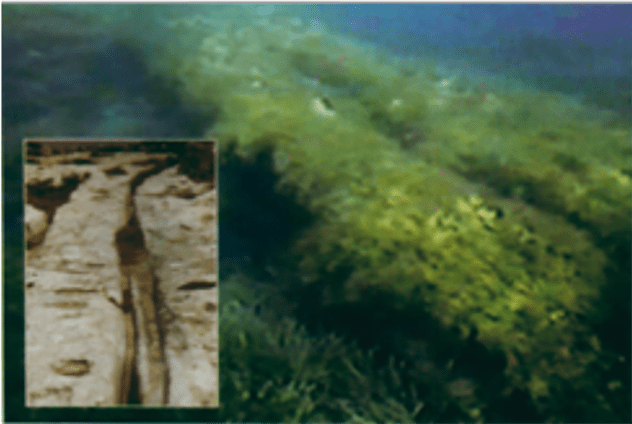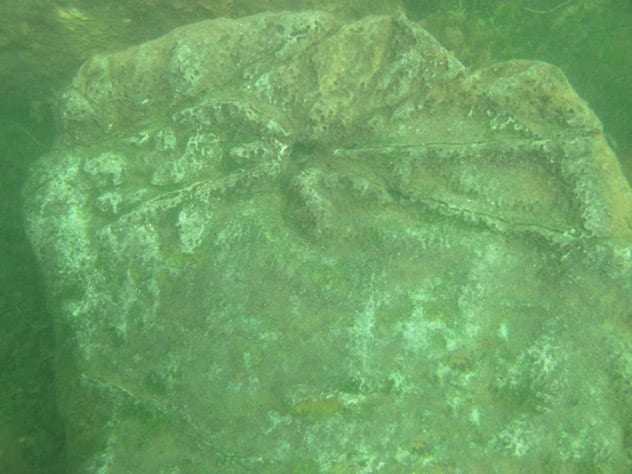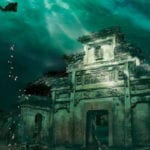 Mysteries
Mysteries  Mysteries
Mysteries  History
History 10 Surprising Stories About the Texas Rangers
 Humans
Humans 10 Philosophers Who Were Driven Mad by Their Own Theories
 Miscellaneous
Miscellaneous 10 Video-Game-Worthy Weapons and Armors from History
 Weird Stuff
Weird Stuff 10 Psychics Who Accurately Predicted Wartime Events
 The Arts
The Arts 10 Pieces of Art Inspired by a Broken Heart
 Health
Health 10 Science Fiction-Sounding New Medical Treatments
 History
History 10 Surprising Facts About the Father of Submarine Warfare
 Space
Space Ten Astonishing New Insights into Alien Worlds
 Weird Stuff
Weird Stuff 10 Bizarre Summer Solstice Rituals Still Practiced Today
 Mysteries
Mysteries Top 10 Haunting Facts About the Ghost Ship MV Alta
 History
History 10 Surprising Stories About the Texas Rangers
 Humans
Humans 10 Philosophers Who Were Driven Mad by Their Own Theories
Who's Behind Listverse?

Jamie Frater
Head Editor
Jamie founded Listverse due to an insatiable desire to share fascinating, obscure, and bizarre facts. He has been a guest speaker on numerous national radio and television stations and is a five time published author.
More About Us Miscellaneous
Miscellaneous 10 Video-Game-Worthy Weapons and Armors from History
 Weird Stuff
Weird Stuff 10 Psychics Who Accurately Predicted Wartime Events
 The Arts
The Arts 10 Pieces of Art Inspired by a Broken Heart
 Health
Health 10 Science Fiction-Sounding New Medical Treatments
 History
History 10 Surprising Facts About the Father of Submarine Warfare
 Space
Space Ten Astonishing New Insights into Alien Worlds
 Weird Stuff
Weird Stuff 10 Bizarre Summer Solstice Rituals Still Practiced Today
Top 10 Underwater Ruins Of Lost Civilizations
There are underwater ruins almost everywhere around the world. However, some stand out more than others due to the suggestion that they might prove lost civilizations existed in the deep past. And, in turn, might even suggest some truth in the many flood myths that also exist around the planet.
Many of these aquatic ruins feature huge megalithic structures, many of which appear to have an intelligent design behind them. Other locations even feature inscriptions of strange symbols and letters in unknown languages. Given that we know very little of what lies beneath the oceans and seas of our planet, who knows what might be awaiting discovery under the still unexplored ocean floors.
Top 10 Places As Mysterious As The Bermuda Triangle
10 Underwater Step-Pyramid Off The Coast Of Yonaguni Jima In Japan?
Perhaps the first name connected to the underwater ruins at Yonaguni Jima[1] off the coast of Japan is Masaaki Kimura. The marine geologist has spent almost two decades studying the ruins. According to Kimura, there are clearly several artificial structures below the waves in the region. One of these even appears to be a “complicated, monolithic, stepped pyramid”. And what’s more, this particular building is over 80 feet tall.
Initially, Kimura would claim that the remains were likely evidence of Mu – an apparently lost continent in the Pacific. He would even claim the dates of ruins to be around 10,000 years old placing them around 8000 BC. He would, however, eventually revise these dates to around between 5000 to 3000 years old.
Despite the revised estimate of the age, though, some researchers remain supportive of the initial estimation. Perhaps most notable of these is Graham Hancock. Hancock has also written of such ruins, most extensively in his book Underworld.
We should also state that not everyone is even convinced the ruins are artificial structures at all. Boston University’s Robert Schoch, for example, would state in 2007 that the remains were most likely “all-natural”. Further study and investigation will likely continue at the site. As will the debate as to what the real truth behind it is.
9 Bimini Road In The Bahamas – A Lost Road To Atlantis?
The remains found off the island of Bimini in the Bahamas referred to as Bimini Road,[2] are certainly intriguing. And are of interest to researchers in both the mainstream and the fringes. Many outside of mainstream research point to the road-like structure and potential buildings as perhaps the best proof of the existence of Atlantis.
The ruins were discovered in 1968 by Joseph Mason Valentine. Upon diving in the crystal-clear waters, he made out what was quickly apparent to him to be a paved roadway running along the seabed. He returned to the waters several times. Each time he discovered further potential outlines of more artificial ruins around the apparent roadway.
The conclusion of carbon dating and research of mainstream scientists is that the road is, in fact, a creation of the natural geological forces of the area. Other researchers, though, point to the area as clearly artificial and with further secrets to reveal.
We might also mention the claims of Ray Brown. He claimed to have found evidence of a sunken pyramid in the region near Berry Island. He made the discovery while hunting for sunken galleons. What made the find even more intriguing, are his claims that his navigation equipment began to suddenly malfunction right before he noticed the pyramid.
8 The Apparent Temples Off The Coast Of Malta

Another location often spoken of with Atlantis can be found[3] off the coast of Malta. The discovery of the underwater temples of Gebel Gol-Bahar took place in the summer of 1999. What perhaps makes the location intriguing is that the person who made the find is a retired businessman and not a scientist. Hubert Zeitmair found the remains around 2 to 3 miles off the coast of St. Julian’s. He is also, however, a follower of the writings of Zecharia Sitchin. And this is something which has led to many people dismissing his finds as “ancient astronaut” nonsense.
To date, no official dating or studies have been made of the ruins. However, many have managed to perform unofficial research. And this suggests that the remains could be many thousands of years old. And what’s more, it is likely, some claim, that the entire area was once inhabited before a major flood hit the region. Some researchers even go as far as to say the area was likely hit by the same flood mentioned in The Bible. Needless to say, almost all researchers in the mainstream dismiss such claims. Some even counter that the boulders and rocks are not at all ancient ruins. They are, in fact, likely the result of illegal dumps.
As well as the structures themselves, though, there also appears to be cart ruts. These run into the water and along the seabed. Cart ruts can also be found in multiple locations around Malta, and are, to some, further evidence of a location that was once not underwater. Furthermore, due to the location and the writings of Plato, many of those researchers suggest that the ruins could very well be those of Atlantis.
7 The Lost City Founded By Krishna, Dwarka, India
Without a doubt, one of the most fascinating locations of underwater ruins is the apparent[4] lost city of Dwarka off the northwest coast of India. Not least as many of the ancient writings of the region are said to be accurate accounts as opposed to legends.
With these legends in mind, many researchers believe the ruins could very well be of the original city founded by Krishna. What’s more, although they are unofficial estimates, some researchers suggest that the city could be 9000 years old. If true, this would make the location 5000 years older than the currently oldest known ancient ruins.
The discovery came to light between 1999 and 2001. During that time the National Institute of Ocean Technology (NIOT) were surveying the region. And rather than murky lines, the remains are clearly those of temples, columns, and stepped buildings. Mainstream estimates suggest that the ruins could be between 4000 to 6000 years old. Other researchers, however, suggest the ruins to be anywhere between 9000 to 12000 years old. These dates would also match those of the alleged floods that are found in multiple creation stories around the world.
6 The Temples Of Mahabalipuram, India
The waters off the coast of south India are also of interest to those looking for underwater proof of lost civilizations. There, there is a continued search to prove that the apparent artificial structures[5] in the region are the temples of Mahabalipuram.
The discovery of the apparent ruins came in 2001. A group of Tamil fishermen claimed to have seen artificial stone structures on the seabed. When official dives took place, it became clear to many that a sunken complex was likely awaiting full discovery. Among other things, they found the remains of walls and fallen pillars. This suggested, to some, a time when the region was very likely inhabitable. The discovery of the pillars, in particular, might suggest some truths to the myths of Seven Pagodas that were said to have once stood at the location.
Perhaps, if solid proof can be found that a lost civilization once resided in either Indian location, the two sites will corroborate each other.
5 A Stonehenge-Like Structure Under Lake Michigan
Maybe one of the most intriguing locations of underwater ruins can be found under the waters of Lake Michigan. There, at an undisclosed location,[6] a henge-like structure resides. The discovery was actually made by mistake by archeologists who were scanning the bottom of the lake in search of shipwrecks. However, when they saw their returns, they would find a clear henge-like structure on the lakebed.
What’s more, they would discover an interesting carving on a boulder of a mastodon. This further strengthened the notion of an ancient presence there before the region was covered with water. This would likely date to thousands of years before accepted records of humans are known to have existed there. Some rough estimates even suggest a date of anywhere between 10,000 to 12,000 years old.
Once more, this date would fit in nicely with the date often given for a global flood. Research continues quietly at the location today.
4 Strange Carvings And Discoveries Under Fuxian Lake, China

At around the same time as the discoveries off the coasts of India in 2001,[7] similar intriguing finds were made under the water of Fuxian Lake in China. And what’s more, legends of a lost sunken ancient city in the region were well-known. The discovery came during a 20-day diving mission of the waters by scientists.
The research team found around 30 buildings in total. And these covered a rough distance of around 25 square kilometers. They did, however, only manage to fully examine and catalog two of the remains. Furthermore, they retrieved over 40 handmade stone relics, including tools, for further study. Even more intriguing, several carvings were discovered on large stones on the lakebed.
Subsequent research missions to the area have seemingly added credibility to the discovery. And although there is little information on who might have lived there, it has since been referred to as “China’s Atlantis”.
3 Port Royal, Jamaica
Port Royal in Jamaica is very much known to have existed – it sunk into the sea in the early 1900s. The location, however, is still of interest to those[8] searching for proof of lost civilizations under the water. It offers, for example, details of how a city can sink below the water, relatively speaking, overnight. This allows researchers, in theory, to better understand how cities lost to the water thousands of years ago might have met their end.
The port itself came into existence in the 1490s when Spanish settlers formed it. It quickly became the largest city in the entire region. And many ships passing through used it as the main trading hub. By the 1600s, however, it had become a region known for vice and criminality. And more concerning, the main port of pirates from around the world.
In 1692, a huge earthquake, tsunami, and several hurricanes severely damaged the port. It remained active, but despite rebuild efforts, it never returned to its golden era. A further earthquake in 1907 essentially finished the city off, sinking it into the sea.
2 The Underwater City Of Pavlopetri, Greece
It would seem the oldest sunken city in the world resides off the coast of Greece in the[9] lost city of Pavlopetri. Although it only became an official find in 2011, rumors of it have existed for decades. In fact, claims of the lost city go back to at least 1904 when geologist, Fokion Negri, spoke of seeing ruins in the region. It would be a further six decades before Dr. Nicholas Flemming appeared to prove Negri’s findings, though. Flemming, along with a team of scientists from Cambridge university, would all but confirm the evidence of a lost city.
The full-scale search of the region between 2009 and 2011 found around 15 buildings at a depth of around 10 to 12 feet. The estimated area of the lost city is thought to be a little over 2 acres. Further research suggests the region once also had a thriving textile industry. What’s more, it was likely once a major trading route in the region.
Whether the city might have existed for thousands of years before the estimated age of 5000 years old remains to be seen. It is certainly one of the most intriguing aquatic locations on the planet.
1 The Pyramid City Off The Coast Of Cuba?
Off the west coast of Cuba lies the remains of[10] a city, with pyramids. And what’s more, the city in question could be as old as 6000 years. In fact, some theories even suggest an age as old as 50,000 years. The researchers who made the discovery, using sonar devices, discovered that some of the underwater stone structures are around 400 meters in width and 40 meters in height.
Rather than being natural formations, it is clear they are of intelligent design. And what’s more, they appear to sit in a planned formation. In short, the discovery appears to be evidence of a city that was at some point in the past overtaken by the waters. Also of interest, are the apparent “symbols and inscriptions” discovered on some of the stonework. Not least as it appears to be an unknown language. Basic research, however, does suggest similarities with Aztec and Mayan symbols.
Although further research is required, the discovery would perhaps vindicate the theories that a land bridge once connected Cuba with Mexico.
10 Things You Probably Don’t Know About The Lost City Of Atlantis








